#Best Selling Products in Europe
Explore tagged Tumblr posts
Text
One of the Best Selling Products in Europe | My European Shop

However, some product categories tend to perform well consistently in Europe. These include: Electronics: Products such as smartphones, laptops, tablets, and gaming consoles are often in high demand. Fashion and Apparel: Clothing, shoes, and accessories from both local and international brands are popular across Europe. Beauty and Cosmetics: Skincare products, makeup, and fragrances are sought after by European consumers. Home Appliances: Items like kitchen appliances, vacuum cleaners, and washing machines are commonly purchased. Automotive: Cars, car parts, and accessories have a significant market in Europe. Food and Beverages: Locally produced food items, wines, and specialty products from various European countries are popular. Home Furnishings: Furniture, decorations, and home improvement products are consistently in demand. It's important to note that the popularity of specific products can vary by country and region within Europe. For the most accurate and up-to-date information on the best-selling products, I recommend consulting market research reports, industry publications, or conducting online research from reputable sources.
#Selling Online in Europe#Fulfillment Centers in Europe#Make in India Sell in Europe#How to List Products on European Marketplaces#Best Marketplaces in Europe#Cross Border Business#Cross Border Ecommerce#How to Sell in Europe from India#How to Sell on European Marketplaces#Buyers in Europe#Online Business in Europe#Best Online Retailers in Europe#Best Selling Products in Europe
0 notes
Text
Versatile Coffee Machine for Home Use
HiBREW 5 in 1 Multiple Capsule Coffee Machine Hot/Cold DG Cappuccino Nes Small Capsule ESE Pod Ground Coffee Cafeteria 20Bar H2B
#Sports#Health & Beauty#Art#Martial Arts#Boxing#Shopping#E-marketing#Online Shopping#Selling#Best Product#Best Seller#Ali Express#Alibaba#Amazon#Music#Entertainment#Laughter#Discounts#Special Offer#Free#Canada#America#Britain#Europe#Coffee Maker#Coffee#Cappuccino#Coffee Making
6 notes
·
View notes
Text
#Explore our comprehensive range of ED medicines#offering effective solutions for enhancing male performance and intimacy. Our online pharmacy ensures discreet delivery and competitive pri#serving customers across the USA and Europe.#Buy ED medicine online#When targeting audiences in the USA and Europe for selling erectile dysfunction (ED) medicine via a website#it's essential to focus on keywords that potential customers commonly search for. Here are some effective keywords and a brief description#**Description:**#**Keywords:**#1. Buy ED medicine online#2. Erectile dysfunction treatment#3. Generic Viagra alternatives#4. Sildenafil Citrate tablets#5. Best ED pills#6. Cheap ED medication#7. Online pharmacy USA#8. Europe ED drugs#9. ED medicine reviews#10. Fast shipping ED pills#These keywords are strategically chosen to target individuals actively searching for ED treatment options#emphasizing affordability#reliability (online purchase and delivery)#and product variety (including generic alternatives). Incorporating these keywords into your website content#product listings#and marketing efforts can help optimize visibility and attract qualified leads from the USA and Europe.#Erectile dysfunction treatment#Generic Viagra alternatives#Sildenafil Citrate tablets#Best ED pills#Cheap ED medication#Online pharmacy USA
0 notes
Text
"Businesses like to talk about the concept of a closed loop or circular economy, but often they’re trying to close small loops. Releaf Paper takes dead leaves from city trees and turns them into paper for bags, office supplies, and more—which is to say they are striving to close one heck of a big loop.
How big? Six billion trees are cut down every year for paper products according to the WWF, producing everything from toilet paper to Amazon boxes to the latest best-selling novels. Meanwhile, the average city produces 8,000 metric tons of leaves every year which clog gutters and sewers, and have to be collected, composted, burned, or dumped in landfills.
In other words, huge supply and huge demand, but Releaf Paper is making cracking progress. They already produce 3 million paper carrier bags per year from 5,000 metric tons of leaves from their headquarters in Paris.
Joining forces with landscapers in sites across Europe, thousands of tonnes of leaves arrive at their facility where a low-water, zero-sulfur/chlorine production process sees the company create paper with much smaller water and carbon footprints...
“In a city, it’s a green waste that should be collected. Really, it’s a good solution because we are keeping the balance—we get fiber for making paper and return lignin as a semi-fertilizer for the cities to fertilize the gardens or the trees. So it’s like a win-win model,” [Valentyn] Frechka, co-founder and CTO of Releaf Paper, told Euronews.
Releaf is already selling products to LVMH, BNP Paribas, Logitech, Samsung, and various other big companies. In the coming years, Frechka and Sobolenka also plan to further increase their production capacity by opening more plants in other countries. If the process is cost-efficient, there’s no reason there shouldn’t be a paper mill of this kind in every city.
“We want to expand this idea all around the world. At the end, our vision is that the technology of making paper from fallen leaves should be accessible on all continents,” Sobolenka notes, according to ZME Science."
-via Good News Network, August 15, 2024
#trees#plants#paper#paper products#sustainability#deforestation#green waste#green waste removal#ukraine#france#paris#good news#hope
5K notes
·
View notes
Text
Saito has made a career of teasing out an eco-theory from the late, unpublished writings of Karl Marx. He earned his doctorate at Humboldt University, in Berlin, and now teaches philosophy at the University of Tokyo. His first book was an English version of his dissertation, titled “Karl Marx’s Ecosocialism” (2017), which tracked Marx’s study of the physical world and communal agricultural practices. (Saito is fluent in Japanese, German, and English.) In a second academic book, “Marx in the Anthropocene” (2022), Saito drew on an expanded repertoire of Marx’s unpublished notebooks to argue for a theory of “degrowth communism.” He gained a following, not only in philosophical circles but among a Japanese public facing the contradictions of tsunamis, billionaires, and same-day shipping. “Slow Down” has sold more than half a million copies in Japan and launched Saito into a rare academic celebrity. He appears regularly on Japanese television and aspires to the public-intellectual status of Thomas Piketty, the French economist who had a surprise hit in his 2013 doorstop, “Capital in the Twenty-first Century.”
The key insight, or provocation, of “Slow Down” is to give the lie to we-can-have-it-all green capitalism. Saito highlights the Netherlands Fallacy, named for that country’s illusory attainment of both high living standards and low levels of pollution—a reality achieved by displacing externalities. It’s foolish to believe that “the Global North has solved its environmental problems simply through technological advancements and economic growth,” Saito writes. What the North actually did was off-load the “negative by-products of economic development—resource extraction, waste disposal, and the like” onto the Global South.
If we’re serious about surviving our planetary crisis, Saito argues, then we must abandon capitalism, with its insatiable appetites. We must reject the ever-upward logic of gross domestic product, or G.D.P. (a combination of government spending, imports and exports, investments, and personal consumption). We will not be saved by a “green” economy of electric cars or geo-engineered skies. Slowing down—to a carbon footprint on the level of Europe and the U.S. in the nineteen-seventies—would mean less work and less clutter, he writes. Our kids may not make it, otherwise.
1K notes
·
View notes
Text
I wanted to make this post much sooner but I have lost track of the days, I apologize!
I will be closing my store TOMORROW, DECEMBER 13. I meant to keep it open, but I decided I’m closing it as I’ve just not felt well enough to pack and take any orders I get, I’ll only be willing to do one more round of packing at most right now.
Additionally, after this day I am stopping orders to Europe due to the new GPSR’s effect on shipping policies coming into effect tomorrow, December 13th. Among other things, it requires heavy and extensive documentation, and a person within the EU I can list as responsible for my product. These are things that I cannot give at this time.
So, I am stopping orders to Europe indefinitely, and I will do my best to figure out if it’s possible to ever somehow pass these regulations legally and get it back up, so I can begin selling to Europe again.
Again I apologize for how last-minute this is, I had lost track of the days.
If you’d like to purchase something now, now is your chance —➡️visit my shop here!⬅️






Additionally, I have plans for next year when I open again in January. Preorders for new products in the later half of the month, a large interest check form, and an attempt to extending my products to Etsy. (I am hoping that maybe Etsy could help with the EU responsible person part in the future at least, but I am unsure).
Thank you for your time! Again I apologize for the closure to EU countries. I will do my best to figure out how to get that going again.
#submas#ingo#warden Ingo#Subway boss Ingo#Subway master Ingo#emmet#Subway boss emmet#Subway master emmet#pokemon legends Arceus#pokemon legends#pokemon Elesa#pokemon akari#pokemon Rei#pokemon Zisu#Pokemon Volo#joltik#hisuian typhlosion#hisuian samurott#hisuian Decidueye#Gliscor#pokemon
71 notes
·
View notes
Photo

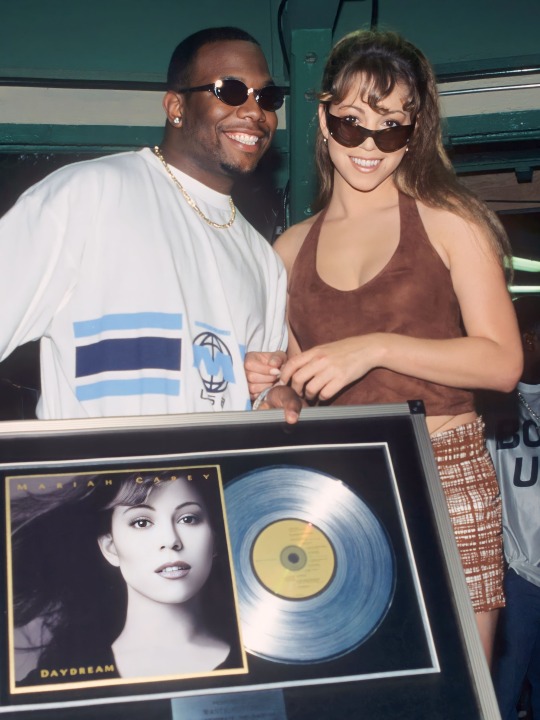








Mariah Carey & Keisha Epps of Total with Wanya Morris of Boys II Men photographed by Kevin Mazur during Camp Mariah & Mariah Carey's Platinum Party for 'Daydream' (July 1996). 'Daydream' is the fifth studio album by Mariah Carey, released on September 26, 1995, by Columbia Records. 'Daydream' received critical acclaim, with reviewers praising the album's production, its sonic quality, and Carey's musical progression. It became Carey's best reviewed album up to that point and garnered six nominations at the 38th Grammy Awards, including for Album of the Year. It was later included on the List of 200 Definitive Albums in the Rock and Roll Hall of Fame. 'Daydream' became a global success, topping the charts in nine countries, and reaching the top five in almost every major music market. It was Carey's second album to be certified Diamond by the RIAA. As of 2019, 'Daydream' has sold over 20 million copies worldwide and is one of the best-selling albums of all time. Six singles were released from the album. Its lead single "Fantasy" became the first single by a female artist to debut at number one on the US Billboard Hot 100 and went on to top the chart for eight weeks, and became the second best-selling single of 1995 in the country. The second single "One Sweet Day" topped the Billboard Hot 100 for sixteen weeks and became the longest-running number-one single in Billboard's history, holding the record for 23 years. The album's next single "Always Be My Baby" reached number one as well. Jointly, the singles from Daydream spent a combined six months at the top of the Hot 100. To promote the album, Carey embarked on the short but successful, Daydream World Tour, visiting Japan and Europe.
916 notes
·
View notes
Text
more on art production ~under capitalism~
reading Who Owns This Sentence?, a very engaging and fiercely critical history of the concept of copyright, and it's pretty fire. there's all sorts of fascinating intricacies in the way the notion of IP formed around the world (albeit so far the narrative has mainly focused on Europe, and to a limited extent China), and the different ideologies that justified the types of monopolies that it granted. the last chapter i read skewers the idea that the ability to exploit copyright and patents is what motivates the writing of books and research/invention, and I'll try and pull out the shape of the argument tomorrow. so far I'm only up to the 18th century; I'm looking forward to the rest of their story of how copyright grew from the limited forms of that period into the monster it is today.
it's on libgen if you wanna read it! i feel like the authors would be hypocrites to object :p
it is making me think about the differences between the making of books and other media, from (since this has been rattling around my head lately) an economic angle...
writing books, at least in the case of fiction is usually done on a prospective, spec-work kind of basis (you write your novel with no guarantee it will get published unless you're already an established author under contract). admittedly, a lot of us probably read books by authors who managed to 'make it' as professional authors and write full time - but this is not a lucrative thing to do and to make it work you need truly exceptional luck to get a major hit, or to be extremely prolific in things people want to read.
the films and games of the types most of us play are, by contrast, generally made by teams of salaried people - and thus do rarely get made without the belief it will be profitable. if you went on about your 'monetisation model' when writing a book, people would look at you funny and rightly so, but it's one of the first questions that gets asked when pitching a game.
open source software is a notable comparison here. a lot of it is done for its own sake without any expectation of profit, taking untold hours, but large free software projects tend to sprout foundations, which take donations (typically from companies that use the software) to pay for full time developers. mozilla, notably, gets a huge part of its funding from google paying for their search engine to be the default in Firefox; this in turn drives development of not just Firefox itself but also the Rust programming language (as discussed in this very enlightening talk by Evan Czaplicki). Blender is rightly celebrated as one of the best open source projects for its incredibly fast development, but they do have an office in amsterdam and a number of full time devs.
what money buys in regards to creative works is not motivation, but time - time to work on a project, iterate and polish and all that. in societies where you have to buy food etc. to survive, your options for existence are basically:
work at a job
own capital
rely on someone else (e.g. a parent or partner)
rely on state benefits if you can get them
beg
steal
if you're working at a job, this takes up a lot of your time and energy. you can definitely make art anyway, loads of people do, but you're much more limited in how you can work at it compared to someone who doesn't have to work another job.
so again, what money buys in art is the means of subsistence for someone, freeing them to work fully on realising a project.
where does the money come from that lets people work full time on art? a few places.
one is selling copies of the work itself. what's remarkable is that, when nearly everything can be pirated without a great deal of effort, it is still possible to do this to some degree - though in many ways the ease of digital copying (or at least the fear if it) has forced new models for purely digital creations, which either trade on convenience (streaming services) or in the case of games, find some way to enforce scarcity like requiring connection to a central server and including 'in-app purchases', where you pay to have the software display that you are the nebulous owner of an imaginary thing, and display this to other players. anyway, whichever exact model, the idea is that you turn the IP into capital which you then use to manufacture a product like 'legal copies', 'subscriptions' or 'accounts with a rare skin unlocked'.
the second is using the work to promote some other, more profitable thing - merchandising, an original work, etc. this is the main way that something like anime makes money (for the production committee, if not the studio) - the anime is, economics-wise, effectively an ad for its own source manga, figurines, shirts etc. the reason why there is so much pro media chasing the tastes of otaku is partly because otaku spend a lot on merch. (though it's also because the doujin scene kind of feeds into 'pro' production)
the third is some kind of patronage relationship, notably government grants, but also academic funding bodies, or selling commissions, or subscriptions on a streaming platform/patreon etc.
grants are how most European animated films are funded, and they often open with the logos of a huge list of arts organisations in different countries. the more places you can get involved, the more funds you can pull on. now, instead of working out how to sell your creation to customers who might buy a copy, under this model you need to convince funding bodies that it fits their remit. requesting grants involves its own specialised language.
in general the issue with the audience patronage model is that it only really pays enough to live on if you're working on a pretty huge scale. a minority make a fortune; the vast majority get a pittance at most, and if they do 'make it', it takes years of persistence.
the fourth is, for physical media, to sell an original. this only works if you can accumulate enough prestige, and the idea is to operate on extreme scarcity. the brief fad of NFTs attempted to abstract the idea of 'owning' an original from the legal right to control the physical object to something completely nebulous. in practice this largely ended up just being a speculative bubble - but then again, a lot of the reason fine art is bought and sold for such eye watering sums is pretty much the same, it's an arbitrary holder of an investment.
the fifth is artworks which are kind of intrinsically scarce, like live performances. you can only fit so many people in the house. and in many cases people will pay to see something that can be copied in unique circumstances, like seeing a film at a cinema or festival - though this is a special case of selling copies.
the sixth is to sell advertising: turn your audience into the product, and your artwork into the bait on the hook.
the alternative to all of these options is unpaid volunteer work, like a collab project. the participants are limited to the time and energy they have left after taking care of survival. this can still lead to great things, but it tends to be more unstable by its nature. so many of these projects will lose steam or participants will flake and they'll not get finished - and that's fine! still, huge huge amounts of things already get created on this kind of hobby/indie/doujin basis, generally (tho not always) with no expectation of making enough money to sustain someone.
in every single one of these cases, the economic forces shape the types of artwork that will get made. different media are more or less demanding of labour, and that in turn shapes what types of projects are viable.
books can be written solo, and usually are - collaborations are not the norm there. the same goes for illustrations. on the other hand, if you want to make a hefty CRPG or an action game or a feature length movie, and you're trying to fit that project around your day job... i won't say it's impossible, I can think of some exceptional examples, but it won't be easy, and for many people it just won't be possible.
so, that's a survey of possibilities under the current regime. how vital is copyright really to this whole affair?
one thing that is strange to me is that there aren't a lot of open source games. there are some - i have memories of seeing Tux Racer, but a more recent example would be Barotrauma (which is open source but not free, and does not take contributions from outside the company). could it work? could you pay the salaries of, say, 10 devs on a 'pay what you can' model?
it feels like the only solution to all of this in the long run is some kind of UBI type of thing - that or a very generous art grants regime. if people were free to work on what they wanted and didn't need to be paid, you wouldn't have any reason for copyright. the creations could be publicly archived. but then the question i have is, what types of artwork would thrive in that kind of ecosystem?
I've barely talked about the book that inspired this, but i think it was worth the trouble to get the contours of this kind of analysis down outside my head...
20 notes
·
View notes
Text
Price to power to size to portability, the AirFanta 3Pro is one of the best on the market. Here's the latest review (Also preserved in our archive)
Afiliate links if you want this guy to make a buck from your purchase: www.amazon.com/stores/AirFanta/page/0D35BA0F-6AFE-48BB-BB83-E984C65192D4?asc_campaign=c192889518f863d96d278a446b3a951d&asc_source=01H1P39M5ZSG9J6WR6B1HBK9M0&language=en_US&linkCode=sl2&linkId=be7b5afa91953d14a40a0b6fb293d6aa&ref_=as_li_ss_tl&tag=namespacebran492-20
air-fanta.com/?dt_id=2137762
AirFanta is a name that I hear more about every day. While it’s a relatively niche company, it’s quickly becoming well-known – at least within the air quality ‘enthusiast’ community – for performant yet affordable air purifiers and air quality monitors. I’ve been using the AirFanta G2 Air Quality Monitor for quite a few months now, but the two products that have always interested me the most are 3Pro and 4Lite air purifiers.
After having the 3Pro set up inside my office for over two weeks now, I am happy to be able to present my full review of the device. For anyone unaware, this purifier is designed to filter a massive amount of air (we will discuss the CADR and more soon!) at a relatively affordable price. It does this by being essentially a pre-assembled CR (Corsi-Rosenthal) Box – a form of air purifier that was itself created due to the need for affordable and effective air purification devices.
While the 3Pro doesn’t embrace the typical DIY aspect of traditional CR Boxes, it has the advantage of having proven performance (no need to worry about whether your DIY box is effective!) and being ready to go out of the box. However, perhaps my favourite aspect of this device over traditional CR Boxes is how easily obtainable it is. While this probably isn’t an issue for anyone in the U.S. or Europe, I find it hard to source good HEPA filters in New Zealand at an affordable price. The 3Pro ensures I don’t run into this issue.
In today’s review of the AirFanta 3Pro, I want to answer a few key questions. Firstly, how does it perform? Secondly, how does it compare to more ‘traditional’ air purifiers? Finally, and most importantly, is the 3Pro worth the markup compared to making your own CR Box at home? By the end of the article, I will share the answers and my opinions regarding each of these questions. Let’s dive in!
The key selling point of the AirFanta 3Pro is its fantastic CADR – especially at this price. For anyone new to air purifiers, CADR stands for clean air delivery rate, which indicates how much air an air purifier can clean and deliver in a set period. The measurement typically used for CADR is CFM, or cubic feet per minute. A higher CADR in CFM indicates the purifier delivers more clean air.
CADR is calculated by considering both the filter efficiency and the airflow through the filters, making it a much better metric (and the standard for air purifiers) than airflow alone. Most CADR tests use a room of around 30m3 and test how much faster the purifier removes particles from the air than if they were left to settle naturally without any other influences.
So, what is the CADR of the 3Pro? It is quite impressive, 413cfm (702 m3/h) at full speed. To best put this in perspective, I recommend reading the fantastic HouseFresh review to see how it compares to other devices currently on the market (spoiler alert; it performs very favourably). I also believe these official figures, as multiple other sources have confirmed them.
The AirFanta 3Pro uses HEPA H11 filters, which are rated to provide ≥ 95% filtration. It’s worth noting that while this figure may not seem that high and that while many air purifiers use higher-rated filters, the H11 filters used here aren’t necessarily bad. That is because, unlike respirators and masks, air purifiers are not designed to purify the air as best possible on a single pass. Rather, if an air purifier can continually filter the same air after multiple passes through the filter, the particle count and concentration will be significantly reduced.
This is important to note because H11 filters are less dense, allowing for better airflow and generally with less noise. Compared to masks, you can think of the balance between filtration and breathability – generally, the more filtration a mask or respirator provides, the less breathable it is. The same goes for air purifiers. The key difference here is that purifiers are designed to have air pass through them multiple times, unlike a mask or respirator, which only has one chance to filter the air before the wearer breathes it. This is why, despite having ‘only’ an H11 filter, the 3Pro can achieve a fantastic CADR.
Of course, this is a very simple explanation, but it’s important to clarify this because I can predict many questions asking, ‘But why weren’t better filters such as HEPA H13 filters used?’. While I can’t speak for the exact answer (you’d have to ask Adam from AirFanta about that!), it’s likely to strike a balance between single-pass filtration performance, airflow, and noise level. While we’ll dive into it soon, I believe complaints about the H11 filter will quickly disappear once you see the performance that the AirFanta 3Pro has to offer.
It’s also worth noting that carbon filters are available, which will provide filtration through adsorption for VOCs and many odours. While I didn’t get these filters to test, some people will opt for them to help manage VOCs. Since these add another layer to the filter, they will likely slightly drop the CADR, but probably not enough to make any significant impact (and, of course, the extra filtration is a big benefit).
AirFanta also has a full list of third-party certifications and test results, which can be viewed here. Interestingly, both bacterial efficiency and viral efficiency reports from Guangzhou Institute of Microbiology Group Co., Ltd. (a CNAS-accredited laboratory) have been provided, and both reports show a > 99.99% decrease in particle concentration after 60 minutes of use in a 30m3 room. The bacterial test goes further and shows the results after 15 minutes, 30 minutes, and 45 minutes. These results show a ≥ 95.63%, ≥ 99.91% and 99.99% drop in tested particles, respectively.
These results show that, at least in a room around 30m3 in size, the AirFanta 3Pro can reduce bacterial and viral particles by ≥ 99.9% in 30 minutes, with 60 minutes seeing a near complete removal of such particles. While we can’t tell exactly what size the particles were in this testing (at least not without paying for access to the original standards), these results are very promising. Potentially worth noting is that since the 3Pro is rated for 702 m3/h, there would have been around 23 air changes within one hour in the 30m3 test chamber. Therefore, the ≥ 95.63% is after almost six air changes, and ≥ 99.91% after around 12.
Of course, these tests and the stated CADR are at the device’s maximum fan speed, which isn’t ideal in many situations. While it’s important to know a device’s maximum performance when needed, it’s more likely you’ll want to leave the device running at a lower speed either all the time or at least quite regularly. Below are the stated CADRs at different fan speeds:
6 – 413CFM 5 – 374CFM 4 – 321CFM 3 – 247CFM 2 – 141CFM 1 – 57CFM Of course, I was also curious to run some tests myself, but I must make the disclaimer that my tests are far from scientific. That said, I wanted to perform some testing similar to a real-life setting where the AirFanta 3Pro is likely to be used. As such, I decided to set up a test room. I measured this room to be 25.6m3, which is about the size of a standard bedroom (it is a bedroom!). While this room is smaller than what I believe this device is intended for, it’s the most controllable room in my house regarding airflow as it only has one door and one window, which can easily be closed and no other forms of ventilation or air disturbances.
In this room, I burned incense until I reached a PM2.5 concentration of 500ug/m3. However, since I can’t exactly control the PM concentration, it ended up being somewhere between 500 and 600 in my tests. I then put the incense out and did a control test to see how long it took the particles to settle without any assistance at all. This took around 90 minutes, and I used this as my baseline.
I monitored the particle concentrations with five AirGradient monitors that were located in each corner and the centre of the room. I then reran this experiment three more times – once with the purifier at maximum speed, once at half speed, and once at the minimum speed to see how long the concentration took to reach < 5ug/m3. I measured the particle concentration by averaging the data from all five monitors to ensure the whole room had been filtered. Here are my results.

In this graph, you can see the baseline data in blue (labelled Ambient) and the particle concentration drop from the AirFanta 3Pro at maximum speed (speed 6) in red. As you can see, it took around 90 minutes for the particle count to drop to < 5ug/m3 without the purifier running but less than 20 minutes with the device at maximum speed. I was very impressed by these first results, and while I wouldn’t want to run the device at full speed often as it is loud, I appreciate having a good peak performance for times when you need to clean the air in a room quickly.

I reran this test, but this time with the 3Pro at half speed (speed 3) and was impressed by the relatively low performance drop. I was worried my results were incorrect, and I reran this three times, but each result was within one minute of the initial result. It looks like a large chunk of the device’s performance is retained between the higher speeds, even though the noise level decreases significantly. This gave me high hopes for the 3Pro’s performance at minimum speed.

Unfortunately, but perhaps not unexpectedly, the device performed far worse at the lowest speed (speed 1). While the particle concentration did drop more quickly than without the device, it was vastly slower than at the faster speeds. It is worth noting that this is not bad at all, as the device is very quiet at this speed and we can see the performance is clearly there, if needed, just turn the device to a higher speed. However, I had inflated hopes after seeing the great performance at higher speeds. Of course, this does match with the stated speed 1 CADR which is roughly 1/8 of the maximum CADR at speed 6.

If we add the times it took the 3Pro to reduce the PM concentration to below 5ug/m3 at each speed setting, we can see that it took between 17.3 minutes and 80.1 minutes to clean the room, depending on the speed. Interestingly, between the higher speeds (speeds 3-6), there appears to be little performance drop-off but a significant improvement in noise levels. At the slow end, the device takes a long time to filter the room, and if you want to use these near-silent speeds, you will probably want to have the device constantly on.
It’s worth noting that previously, the AirFanta 3Pro came with a voltage dial on the adapter. This could be used to adjust the speed, and many reviews of the device still refer to this voltage dial (essentially, a speed dial). Newer versions come with a speed dial with speeds 1-6, so I have referred to speeds instead of voltages for this section.
Before concluding this section, I was also curious how this device would perform if I lit incense in the room while the air purifier was on. I didn’t have a reason for doing this other than curiosity. Still, considering the stellar performance at the higher fan speeds, I wondered how the purifier would handle a pollutant source emitting particles while the device was running. Below, you can see the results (keeping in mind that this same room reaches over 1000ug/m3 when burning incense without an air purifier).

As you can see, the AirFanta 3Pro significantly reduced the maximum particle concentration in the room and rapidly cleaned the air once the incense finished burning. I would be very confident using a device such as this even during periods of heavy pollution, such as during wildfire season.
Overall, I’m quite impressed with the performance of the AirFanta 3Pro, and although it’s loud at full speed, it’s great to know that it’s more than capable of cleaning a small to medium-sized room quickly when needed. Larger rooms will take longer to filter, but I am confident this device can do it based on this performance.
If you prefer a quieter device, you can still use the AirFanta 3Pro, but you will want to leave it at a lower speed and constantly have it on. Thankfully, at the lower speeds, it’s a relatively quiet device, and I found it easy to work even with the purifier constantly on – as long as it was set to a lower speed, such as 1 or 2.
On the certifications page (located here), AirFanta also discloses and publically makes its results from non-performance-related certifications publicly available. There are a few pertinent and important documents here, so let’s discuss these before moving on. For the 3Pro, we can find the following documents provided:
UL507 certificate of AirFanta 3Pro CE-EMC certificate of AirFanta 3Pro and 4Lite CE-LVD certificate of AirFanta 3Pro and 4Lite FCC certificate of AirFanta 3Pro and 4Lite California Air Resources Board certification of Airfanta 3Pro Let’s review these individually, beginning with the UL507 certificate at the top. This certification might seem minor, but this is a safety standard for low and mid-powered fans such as those in PCs, kitchen hood vents, and, obviously, some air purifiers. The documentation for this certification is extensive (around 200 pages long), but this certification ensures the fans on the 3Pro are safe from a range of potential issues.
The next two certifications, both CE certificates from the European Union, indicate that the device meets EMC (electromagnetic compatibility) and LVD (low voltage directive) requirements. These are essentially further safety tests and indicate that the device is safe and provides high protection from potential EMC and LVD dangers.
The FCC certificate shows that the AirFanta 3Pro complies with FCC requirements, which are pertinent to customers from the United States. Still, these certifications are also helpful for trust-building with global customers. While I’m not U.S.-based, I certainly feel more confident in a product if it’s also FCC-compliant.
Finally, the CARB (California Air Resources Board) certification shows that the AirFanta 3Pro complies with California’s electrical safety and ozone requirements. This is particularly important as ozone can be a big issue with some air purifiers, and it’s reassuring to know that this is not an issue in the case of the AirFanta 3Pro.
If you’ve ever seen a CR Box, you will already know exactly what to expect from the 3Pro because that’s exactly what it is – a CR Box with pre-chosen parts that come as one ready-to-assemble package. While CR boxes aren’t that hard to assemble, the 3Pro streamlines the process and removes the difficulty of selecting and choosing your own parts. While some enthusiasts might opt for another CR Box, many other prospective customers will appreciate this approach.
When you open the 3Pro’s box, you will be met with six ‘layers’ that must be assembled. This is a very clean approach, as it means that the packaging for the device is relatively compact (albeit still quite heavy), and it even means that the device can be transported and reassembled easily. While it would be a stretch to call this device portable (that’s what the AirFanta 4Lite and SmartAir QT3 are for!), this means it is far more compact than other air purifiers with similar CADRs. While it is still quite large, you could easily take it on the road and use it at hotels, or perhaps even fly with it if you are taking large suitcases.
Back to actually assembling the product! Once you open the box, you will see six panels layered on top of one another. These are the cube’s six sides, with four being HEPA filters, one being a solid plastic base for the device, and the final being the top, where the four fans are located. Assembling the device is easy, and you will want to place the base on the ground before slotting the four filters into it. The only potential difficulty with assembling this purifier is holding the four sides in place as you slot the top on, but even this is quite straightforward with the included velcro intended for exactly this purpose.
A manual is included, but the device is so easy to put together and take apart that I can’t imagine anyone ever using it past the first assembly. Even then, it’s not really needed, as assembling the device is quite self-explanatory. The only note I think might be important to the user is that the mesh surface on the filters should be facing outwards (not the filtering surface, which should face inwards).
All of this is to say that assembling the device is very straightforward, and no one should be scared away or turned off this device because it has a small DIY element. It’s also a bit easier to assemble than other CR boxes as the slots have already been cut out of the base plate, and everything can be put together without the need for glue, tape, or other materials. Perhaps more helpful, the filters have already been chosen, and there is no need to shop around for the best price-performance filter.
Once assembled, the device takes the shape of quite a compact CR Box. On top of that, I must add that I think this device also looks a lot better than any traditional CR Box – at least any that I’ve ever made! While it still has an industrial look, it’s a device that could quite easily fit into a classroom, office, or room without attracting too much attention. While I value aesthetics much less than performance, I appreciate having a device that looks good, too – especially if it can blend in.
Once assembled, the device feels quite solid, and despite there being no adhesive or tape used in the assembly of the purifier, I feel confident lifting it and moving it without dislodging the pieces. With that said, I tend to lift the device from the bottom and hold the top down to ensure none of the pieces slide out from their intended positions.
On top of the purifier are four large fans connected to a controller that will allow you to adjust the speed of the device. These fans look almost identical to large PC fans, and they’re held in place by a wire bracket that also serves as an extra layer of protection to stop any children or animals from getting fingers or paws into the fans. That said, if you have the device around children, you may want to place it up higher so they can’t easily reach the fans.
That’s really all there is to the design of this device. It’s very simple, but it’s also affordable and performant. While some might miss the smart features and connectivity of more pricey air purifiers, the two types of devices cater to very different customers. Overall, I’m a fan of this straightforward approach, which reminds me of the SmartAir Sqair.
The AirFanta 3Pro uses four 140mm fans to push air through the filters. Characteristically, smaller fans tend to have higher-pitched sounds than larger fans and the AirFanta 3Pro sits somewhere in the middle as it uses medium-sized fans. If you have a desktop PC with a case fan (not the other fans, such as the higher-pitched CPU fan), you’ll likely already know what these fans sound like, as most desktop cases use 120mm or 140mm fans. This isn’t an unpleasant sound, but it is quite audible.
To see how loud the AirFanta 3Pro is, I conducted noise tests at 30cm and 2 metres with a sound level metre that measures in dBA (A-weighted decibel). dBA differs from traditional dB because it is adjusted for the human ear’s sensitivity to different frequencies. Low and very high frequencies are de-emphasized, mimicking how humans perceive loudness. In other words, it’s a better representation of the actual noise level than dB for a device such as an air purifier. However, I do want to note this as many other websites use dB, which will explain why my results are significantly different.
For further context, here are a few examples of the volumes of some noises in dBA. Obviously, these can vary, and especially with dBA, they will vary between different devices. However, they are rough examples:
10 dBA – Breathing or leaves rustling: Extremely quiet. 30 dBA – Whispering: Comparable to a quiet library. 40 dBA – Refrigerator hum: A typical low background noise. 50 dBA – Moderate rainfall: Light, soothing noise. 60 dBA – Normal conversation: The sound of talking at a close distance. 70 dBA – Vacuum cleaner: Considered moderate noise, can be annoying over time. 80 dBA – Heavy traffic or a loud alarm clock: Noise becomes uncomfortable after prolonged exposure. As you can see, at the lowest speeds, the 3Pro doesn’t add much to the noise of most rooms, but at the highest speeds, it can sound almost as loud as a vacuum cleaner (provided you are close to it). This is a lot of variation, but I like how this device gives the user full control over speed and noise, allowing them to pick a good balance.
I think most people will have this device running on speed 2 or 3, and both sounds are very manageable at a distance. If you do want a short burst of cleaning, the device will be significantly louder, and that’s why I only recommend using the higher speeds when needed.
When it comes to power consumption, the device can go from very low power to relatively high power. Here is a list of the wattage and voltage at each fan speed:
6 – 33.2 watt – 12v 5 – 27.4 watt – 11v 4 – 18.9 watt – 9.3v 3 – 11.1 watt – 7.3v 2 – 4.7 watt – 4.8v 1 – 2.2 watt – 3.0v I won’t dive into power costs here because those vary greatly depending on where you reside, but I hope these specifications can give some insights. What’s most impressive to me is how much range this device has, whether we are discussing volume or power draw. There is such a large range that you can choose exactly what setting works best for you and leave the device to it.
The AirFanta 3Pro costs $149 or $159 (USD) depending on whether you opt for the CE-certified or CARB-certified version (the CARB variant is the lower priced of the two). It’s surprising to see a different price on these two units, but I assume it’s due to extra costs, either with the CE certification or getting the device into Europe. Either way, if you’re in the U.S. (or any non-EU country), the CARB variant will work, and that’s the model I received.
In the box, you will get six panels to assemble the 3Pro. This includes four HEPA H11 filters, which, as per AirFanta, should be good to last 6-12 months, depending on air quality conditions. In most cases, I would assume these filters will last closer to 12 months, but those who experience severe wildfire seasons or whose homes are exposed to consistent year-round pollution may need to replace the filters more regularly.
When you need your first filter replacement, you can opt for the default H11 filters or H11 filters with activated carbon. Interestingly, it doesn’t seem you can choose the filters you get with the device initially. If you want activated carbon filters from the get-go, you must purchase the device alongside an extra pack of filters. The activated carbon filters will set you back $74.99 compared to the basic filters, which cost $54.
The filters aren’t cheap, but it’s important to remember that each filter replacement pack you order has four individual filters, which is a substantial amount of filter materials. It’s also important to note that, unfortunately, you will need to purchase official AirFanta filters as they are smaller than most square HEPA filters, and other filters will not fit on this device. I don’t think this is a big deal, as I appreciate the smaller form factor of this device over larger devices, and even four HEPA filters from other brands will not be cheap.
If we estimate that most users use each set of filters for around nine months, your yearly filter costs for non-activated carbon filters will be $67.5. On the other hand, if you opt for the extra VOC adsorption of the carbon filters, you are looking at an ongoing cost of just under $100 per year. This is in a similar price range to other equally performant air purifiers, and this device’s initial cost is also much lower.
While power cost also needs to be factored into the ongoing cost equation, that cost will vary significantly depending on your air purifier usage (hours, speed, etc) and location. However, regardless of usage patterns, you should plan to spend between $67 and $100 on replacement filters for this device every year.
Overall, I’ve been very happy with the AirFanta 3Pro. While it’s not a perfect air purifier – if one even exists – this is a fantastic device that balances many difficult factors. Ultimately, it comes in as an affordable air purifier that doesn’t skimp on performance. In fact, it has a higher CADR than many more (and much more) expensive air purifiers. Furthermore, it offers a wide range of speeds that allow the user to choose the ideal balance between speed and sound for the setting.
I’ve always been a fan of the CR box concept, but I think the AirFanta 3Pro takes this a step further and, due to this, will appeal to many more people. While I’ve never had an issue constructing CR boxes, I often have difficulty sourcing the parts (especially good filters), and I appreciate how the 3Pro can provide the same or better performance at a slightly higher price while also simplifying the shopping process for me.
Surprisingly, for a device of this size, it’s also quite portable, and you will be hard-pressed to find anything that provides a higher CADR than this device while also being ‘packable’. While I still wouldn’t go so far as to say it can fit in a backpack, it can definitely fit in a car or suitcase and is ideal for longer trips where you might be staying in hotels with unknown air quality. If, on the other hand, you want to use it around the house, it’s also a great device.
The biggest disadvantages I see with the AirFanta 3Pro are the sound and the design. There’s no denying that while the device is powerful, it’s also loud at its higher speeds. While this isn’t unusual for an air purifier, it is worth noting that you probably won’t want to run this device at its higher speeds unless necessary. I usually find myself using speed 2 or 3, which is the sweet spot for most users. On the upside, the lower speeds are almost silent, and although they significantly diminish performance, they are good for users who are okay with constantly running the device.
The design may also bug some users. While I don’t mind (and actually like) the device’s industrial design, I know some people don’t use CR boxes due to the design. If you don’t like the look of CR boxes, the chances are you also won’t like the design of this device. With that said, this design allows this device to have such a good price-to-performance ratio, and I think many potential customers will appreciate this more.
Overall, the AirFanta 3Pro is a cost-effective air purifier that should be on your radar – especially if price is a concern. If you’ve tried the 3Pro, I would love to hear your thoughts, so please feel free to use the comments section below! Furthermore, if you have any remaining questions, please don’t hesitate to as,k and I will do my best to reply. Thank you for reading.
Pros: High CADR (413 cfm) for effective air purification Affordable compared to similar high-performance devices Pre-assembled CR box design simplifies setup Portable and compact for travel use Certified for safety (UL507, CE-EMC, FCC, CARB) Cons: Loud at higher speeds Design may not appeal to all users (industrial look) Limited to proprietary filters, increasing costs No activated carbon filters included in basic kit
#mask up#public health#wear a mask#pandemic#wear a respirator#covid#still coviding#covid 19#coronavirus#sars cov 2
18 notes
·
View notes
Text

Quincy Jones
Musician, producer and arranger who had global hits with Michael Jackson, was the first black composer to find acceptance in Hollywood and won 28 Grammys
From the 1980s onwards, Quincy Jones, who has died aged 91, was best known for his production and arranging work with Michael Jackson, not least because his efforts on Jackson’s album Thriller helped make it one of the bestselling albums in pop history. But the superstar glare surrounding his work with Jackson tended to conceal the fact that there were many more layers to Jones’s abilities.
He worked with jazz stars such as Count Basie and Dizzy Gillespie, became a friend and collaborator of Frank Sinatra, and developed a flourishing career as a composer of soundtracks for film and TV. He enjoyed success under his own name in styles ranging from big-band jazz and swing to pop, soul and funk. He became an influential music business executive, a successful entrepreneur in film and TV production and launched the music magazine VIBE.
He was born in Chicago, the son of Quincy Jones Sr, a carpenter and semi-pro baseball player, and his wife, Sarah (nee Wells), a building manager. His parents divorced, Quincy Sr remarried, and the family moved to Bremerton, Washington, during the second world war, then to Seattle. Quincy Jr began playing the trumpet and singing in a gospel quartet at the age of 12, and when he met up with the teenaged Ray Charles, also based in the Seattle area, Charles encouraged him to take an interest in arranging. A course at the Berklee College of Music in Boston set Jones up for his first professional job, in 1951, with the bandleader Lionel Hampton.
His experiences on the road with the Hampton band were an eye-opener. “You couldn’t stay in white hotels, and to me, coming from Seattle, a lot of this stuff was like a slap in the face,” he said. “Back then, all the black bands had white bus drivers so they could eat, ’cos you couldn’t go into white restaurants. Even in Philadelphia, they had segregated hotels.” Jones left Hampton in 1953, having accompanied the band on a European tour and rubbed shoulders with a remarkable lineup of musicians including the trumpeters Clifford Brown and Art Farmer.
He set about making a living writing arrangements for jazz luminaries including Basie and Tommy Dorsey. Although Jones put in a stint as musical director for Gillespie’s ensemble in 1956, he was aware that the days of the big bands were numbered, and rock’n’roll was coming. “In a funny way, Lionel Hampton was one of the bands that was serious with a rock’n’roll sensibility, before we even knew what the word meant,” Jones said.
During 1957 and 1958, Jones based himself in France and Scandinavia. He continued to study composition – notably with Nadia Boulanger, mentor of Leonard Bernstein and Aaron Copland, among others – and took a job with Barclay Disques, the Paris-based subsidiary of Mercury Records. While in Europe he formed a star-studded big band of his own, and spent two years touring Europe and the US. He wrote material for Count Basie, and during the late 1950s and early 60s worked as an arranger and music director on recording sessions for vocalists including Billy Eckstine, Ella Fitzgerald, Dinah Washington and Sarah Vaughan.

In 1964, Jones won his first Grammy award, for his arrangement of Basie’s song I Can’t Stop Loving You. He also produced four million-selling singles for Lesley Gore, including the US chart-topper and UK Top 10 hit It’s My Party (1963). His hectic career was matched by an equally eventful private life. In his memoir Q: The Autobiography of Quincy Jones (2001), he described how at one point he was dating five women at the same time.
His burgeoning profile was boosted by collaborations with Sinatra, Sammy Davis Jr and Andy Williams. Jones’s association with Sinatra produced the albums It Might As Well Be Swing (1964) and Sinatra at the Sands (1966), both featuring Basie’s band. Jones and Sinatra became close friends, Jones later writing that Sinatra was “hip, straight up and straight ahead, and above all, a monster musician”.
Jones’s track record gained him entry into the lucrative fields of film and television, and he became the first black composer to find acceptance within Hollywood. Throughout the late 60s and 70s he was commissioned to write scores for more than 30 movies and hundreds of TV shows. Among his better-known film projects are In Cold Blood (1967), In the Heat of the Night (1967), The Italian Job (1969) and The Getaway (1972). The theme from Ironside is his most instantly recognisable effort for the small screen, but his compositions for The Bill Cosby Show, Sanford and Son and his Emmy-winning work for the miniseries Roots proved enduringly popular.
As the 70s wore on, Jones displayed his instinct for moving with prevailing musical trends by immersing himself in funk and disco music. His album Body Heat, from 1974, featured the Brothers Johnson as the rhythm section, and Jones subsequently produced bestselling albums by the Brothers Johnson themselves.
Despite undergoing surgery to deal with twin brain aneurysms in 1974, Jones continued to work at a furious pace. He produced chart-busting albums for the disco queen Donna Summer and soul diva Aretha Franklin, and he found another musical soulmate in the guitarist George Benson. Their collaboration on Give Me the Night (1980) – the debut release on Jones’s Qwest label – was another career benchmark, the album reaching No 3 on the US album chart while the title track was a No 4 single.
Meanwhile Jones had hits under his own name. He had a US Top 30 success with Stuff Like That (1978), and in 1981 scored a Top 10 album with The Dude, which spun off the Top 30 hit Ai No Corrida (No 4 in the UK), and the Top 20 hits Just Once and One Hundred Ways, both featuring James Ingram. In 1998, the hit movie Austin Powers prompted a revival of Quincy’s 1962 hip-shaker, Soul Bossa Nova; it was also used as a theme for the 1998 football World Cup in France.
Jones first met Michael Jackson, then aged 12, at Davis Jr’s house, but it was not until Jones was working on the soundtrack for the film The Wiz (1978), starring Jackson and Diana Ross, that he was invited to produce a Jackson solo album. This was the 20m-selling Off the Wall (1979). Their collaboration continued with Thriller (1982) and Bad (1987), the trio selling 100m copies between them. In between, Jones was also the natural choice to produce the 1985 charity single, We Are the World, co-written by Jackson and Lionel Richie and performed by the all-star USA For Africa to benefit Ethiopian famine victims.
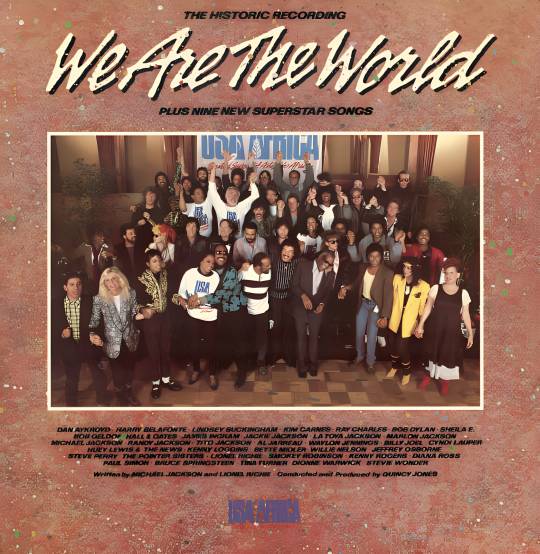
Jones was a pivotal figure in helping musicians take control of the business side of their work. Like most other musicians, he had grown accustomed in the early years of his career to having his royalties and copyrights appropriated by unscrupulous publishers or record labels. “If you write a song, the publishing is 50% of that,” Jones explained. “They would say: ‘I want 50% of your creation’, so that means you get 25%. That was normal.” He began to see the light when he took a job as A&R man at Mercury Records in New York in 1961. Within two years, he was made a vice-president, making him the first high-level black executive of a major record label. “I’d lost so much money when I had my band [the Jones Boys] in Europe that I had to go with a record company. That’s when I said: ‘I’d better pay attention to the other side, because it is a music business.’”
After moving from Mercury to A&M Records he launched Qwest, which became home to such varied artists as New Order, Milt Jackson, the Winans and Tevin Campbell. Qwest also did excellent business with the soundtracks to Malcolm X (1992) and the rap-generation movie Boyz N the Hood (1991).
Growing into the role of entertainment mogul, Jones co-produced Steven Spielberg’s film of The Color Purple in 1985 and produced its soundtrack. In 1990 he teamed up with Time Warner Inc to form Quincy Jones Entertainment; in 1991 he helped create the NBC television series The Fresh Prince of Bel Air, which launched Will Smith on the road to superstardom; and in 1993 he set up VIBE. He headed a consortium of businessmen that formed Qwest Broadcasting, which purchased TV stations in Atlanta and New Orleans.
Jones won an Emmy, 28 Grammys and three Special Grammy awards, including the Grammy Legend award in 1992, was given the Sammy Cahn lifetime achievement award from the Songwriters Hall of Fame in 1989, and was inducted into the Rock & Roll Hall of Fame in 2013. He was showered with honorary doctorates, Time magazine declared him one of the most influential jazz musicians of the 20th century, and in 1990 he was made a chevalier of the Légion d’honneur, promoted to commander in 2001.
He was celebrated in the film Listen Up: The Lives of Quincy Jones (1990) and the documentary Quincy (2018), directed by his daughter Rashida.
Three marriages ended in divorce. He is survived by a daughter, Jolie, from the first, to Jeri Caldwell; a daughter, Martina, and son, Quincy, from the second, to Ulla Andersson; two daughters, Rashida and Kikada, from the third, to Peggy Lipton; and by a daughter, Kenya, from a relationship with Nastassja Kinski, and a daughter, Rachel, with Carol Reynolds.
🔔 Quincy Delight Jones Jr, musician, producer, composer and arranger, born 14 March 1933; died 3 November 2024
Daily inspiration. Discover more photos at Just for Books…?
13 notes
·
View notes
Text
Online Marketplaces in Europe

Marketplaces in Europe provide access to millions of prospective clients, making them essential to cross-border commercial success. These platforms provide various product categories and appeal to a diversified clientele. Businesses must assess each platform’s audience, competitiveness, and seller criteria before putting items on a marketplace to determine the best match for their products.
#Allegro#Zalando#Sell in Europe#Marketplaces in Europe#Importers in Europe#Best Selling Products in Europe#Best Online Retailers in Europe#Online Business in Europe#Buyers in Europe#How to Sell on European Marketplaces#How to Sell in Europe from India#Cross Border Ecommerce#Cross Border Business
0 notes
Text
NB F80 Desktop Gas Spring LCD LED Monitor Holder, Arm Mount, 17-30", Full Motion Display, Load Bearing 2-9kg, New, 2021

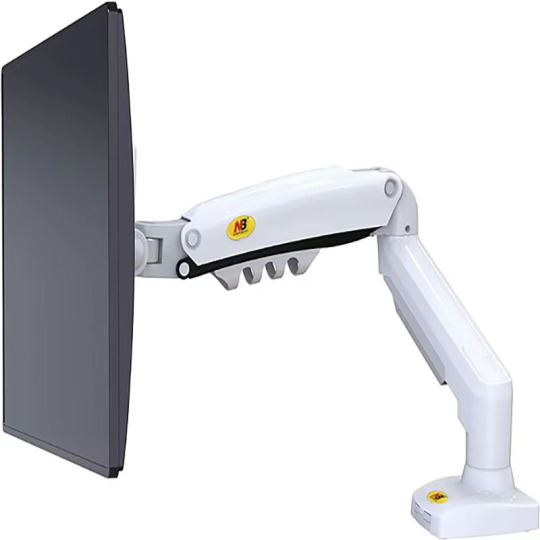
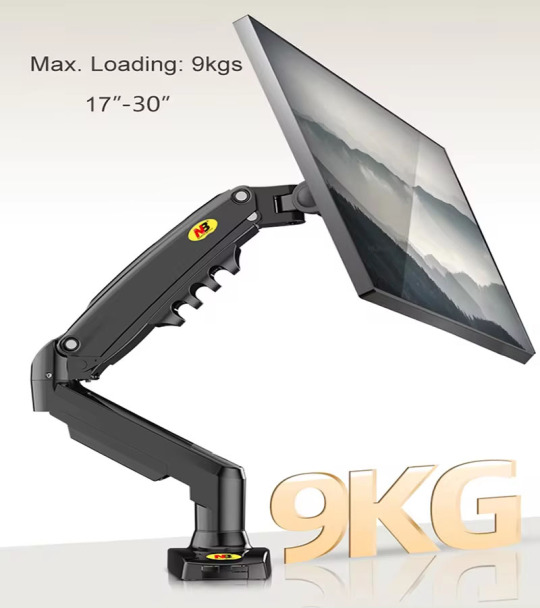
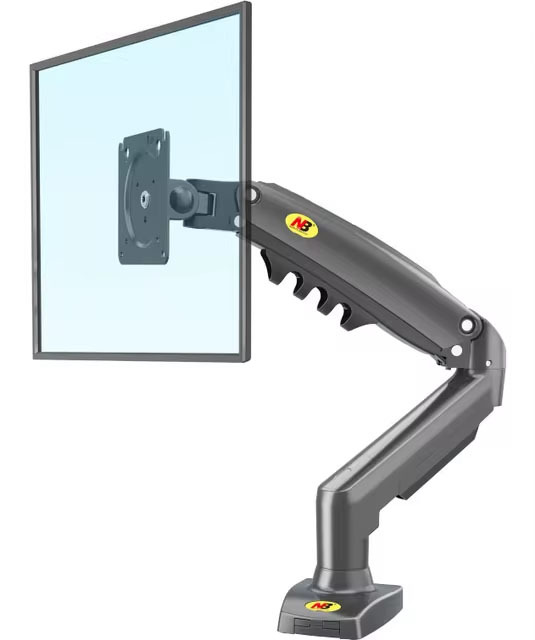

#Sports#Health & Beauty#Art#Martial Arts#Boxing#Shopping#E-marketing#Online Shopping#Selling#Best Product#Best Seller#Aliexpress#Alibaba#Amazon#Music#Entertainment#Laughter#Discounts#Special Offer#Free#Canada#America#Britain#Europe#gumroad#shopping
6 notes
·
View notes
Text
Also someone asked "what's wrong with Nu Metal?" and the best I can explain it is;
Nickleback is Nu Metal.

But in a better explination; Nu Metal is super commercialised which also affects both the way it sounds and its visuals. It's the most"Mainstream" of any metal genre.
Another aspect... and this is not an insult, this is just the way it is.... is that Nu Metal is largely American. Why does this matter? Well, because in Europe, because all the countries and subgenres are rubbing elbows with each other all the time, there is an inherent push and flow, with bands influencing each other stylisticly while also pushing for higher quality and a greater uniqueness in if not sound then identity to make a mark on the metal landscape.
But in America, there just are not as many metal bands in "the mainstream" that compete with the big hitters. Not te mention toe lack of influence and give and take between bands and genres means there is little to no need to push for greater quality or individuality.
Why improve if you already think you're the best?
This is also why American metal is considered very "mid" by fans who listen to the European artists, even if there are certain American artists they will acknowledge as a favourite.
There is also the fact that many bands falling under "Nu Metal" reject the label as being part of metal in general, which comes across as insulting.
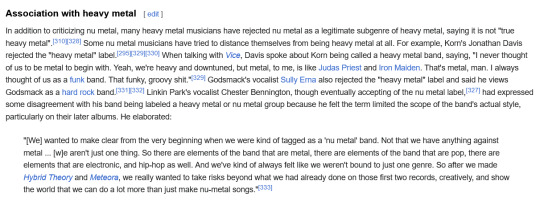
So it's a combination of factors;
1: Overly mainstream and commercialised
2: overall lack of quality
3: severely dumbed down to appeal to a wider audience as a product to be sold.
4: general disrespect by "Nu Metal" artists who respond to criticism of selling out as Nu Metal by saying "well we were never metal anyway so fuck you"
Wikipedia has a whole subsection on why Nu Metal is widely criticised by both metal fans, bands, and the general music landscape
Is it perhaps hated to a hyperbolic level? Maybe. One can't deny the impact it has had on the history of the music scene as a whole. But as far as being a fan of the genre goes...
It's like saying your favourite genre of movie is "Marvel".
27 notes
·
View notes
Text
Asians are all the same, right? The racism of a company cock gurgling moron
Like herpes and unlike the Dobbear, I am back baby.
At this point, deepest apology for my long absence. Personal issues over the last two years prevented me from writing anything and also destroyed for the longest time any desire to really continue the blog.
However, I don’t want to let things unfinished and seeing how the hypocricyofandrewdobson still manages to get some rise out of old Dobson related stuff, I wanted to just return, in order to properly contribute a bit more critical thinking in regard to his old comics.
And while I will not immediately return to my retrospective of SYAC, here is at least (for a start) my opinion on one comic of his, that in my opinion just proved hilarious and controversial in hindsight, and rather racist even back then.
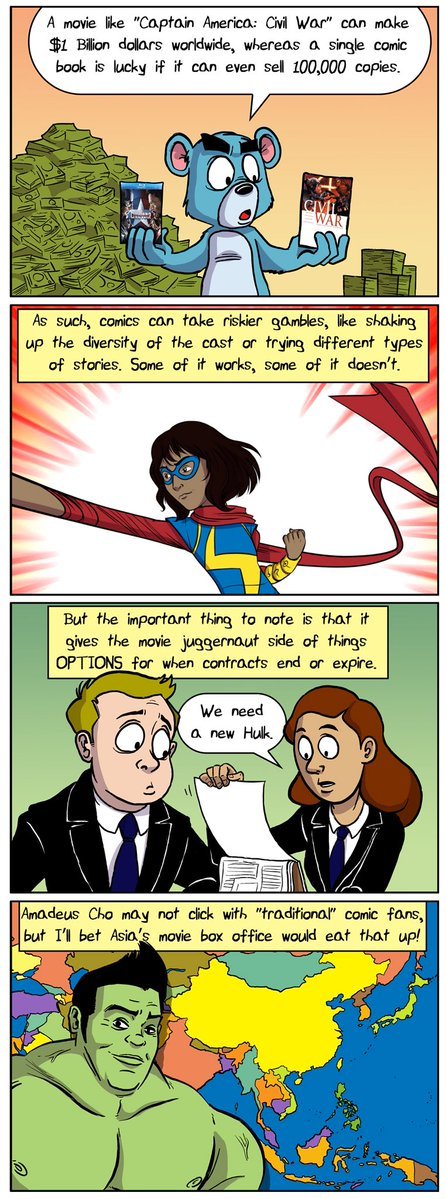
I admit, I don’t know anymore what the title of the comic here is. All I know is, that it came out around 2018, shortly after the release of his “Black Panther” comic, another malignant piece of Dobtrash that has made the rounds online ever since. However, unlike the Black Panther comic, which became the center of a lot of discussion regarding Dobson’s racist assumptions about comic book fans while ironically trying to present himself as woke, this one was weirdly drifting off into obscurity. Which is kinda weird, cause in my opinion, it is way more racist and actually kinda insulting to the very craft Dobson supposedly “dedicated” his life to.
Let me explain.
First, over the course of three panels, Dobson comes essentially off like he is considering the medium of comics as inferior to the medium of movies. Making it look as if comics are unsuccessful because they cannot rail in the same amount of money than certain flics and calling them at best nothing more but a pitching ground for corporations to create new shallow mass product.
Now I am a bit of a realist and I know that, especially in the world of mainstream American superhero comics, this is kinda the case. Most comic book characters, stories and franchises are owned by multibillion dollar corporations, who either have a direct hand in the creation of the product (via corporate mandate for example) and/or use the likeness of the product to make profit in additional, more valuable revenues than the printed medium. Such as cartoons, merchandise and movies. One example I can think of, to show that it isn’t just an American issue: Yugioh. The card game wouldn’t have come to be if there hadn’t been a manga starring a little boy putting together an ancient Egyptian puzzle, but while the original manga ended way back in March of 2004, the card game makes millions globally still after 25 years and counting.
But that doesn’t change the fact, that comics as a medium still have value. Without the stories told within their pages, we wouldn’t have characters such as Captain America, Superman, the Mask, the Ninja Turtles and so on to begin with. Don’t get me even started on stories that aren’t falling into the American mainstream comic trend, but still succeeded in the printed comic medium partly because of genuine artistic and profound value such as Maus, Barefoot Gen, Watchmen, V for Vendetta, TinTin and a shitton of (other) stuff from Europe and Asia.
So when Dobson, who always acted like he is proud to be a cartoonist and that comics are a superior medium to others, suddenly reduces them to just being a “pitch ground for better stuff down the line” at best, I as a fan of the medium and just the art of creating stories in itself, get kinda pissed.
Additionally, the way how he compares movies to be better than comics, is severely flawed.
He brings up the fact, that “Captain America: Civil War” made over one billion dollars at the box office as an example, while pointing out the fact, that most single comic issues barely manage to sell 100.000 copies, while holding up a copypasted “Civil War” issue.
Already, Dobson essentially compares apples with bananas, while also giving both false and incomparable data, that also ignores many aspects to be considered.
For starters: He compares the earnings of both movies and comics with two different values. For movies, he goes by the monetary profit a superhero movie could possibly make, while for the comic issue, he goes by the total number of copies sold.
But here is the thing: Assuming the average selling price of a comic is at 4 dollars for a single 30 page issue, selling 100.000 copies would ring in like 400.000 dollars. And considering that producing one issue likely costs a company less than 20.000 dollars (obvious costs for mass production and distribution not withstanding) they can still make a decent profit this way from ONE issue alone. One issue. Not multiple issues of a long running, but sadly underperforming series. All of that by the way doesn’t even account for the fact, that most single issues at best tell only a quarter of a decent short story nowadays and ignores later “long term” factors, such as reprints of the issue, late term buying of the issue, tradepaperback sells of the issue, the longterm effect and cultural impact the issue may have on the actual series or plot continuity (such as Amazing Spiderman 122, aka “The Night Gwen Stacy Died”). Don’t get me even started on the fact, that many of these issues get first sold in the US and only over the course of one year or longer may then additionally be sold in other parts of the world, therefore bringing in even more money for the publisher.
Example: The Duck comics by Don Rosa, which earn more than four times more in Europe, than they ever did in America, despite the guy being from California. Finally, a a little add addendum: that example Dobson gives indirectly via the “Civil War” issue? A quick google search revealed, that Civil War issue 1 sold over 300k copies in May of 2006 alone. Sure, not necessarily the best numbers ever for a single issue (as evident by the following list: https://bookriot.com/bestselling-comics-of-all-time/ )but still nothing to be ashamed of.
And yes, I know that we live currently in a time, where comic book sells have dropped significantly for a variety of reasons, one of them being an overall lack of decent stories. But as long as other stuff still manages to run freaking circles around American superheroes (*cough* One Piece *cough*) I wouldn’t say the medium itself is dead. Just a specific branch of it is suffering from a lack of quality and the customers are jumping ship.
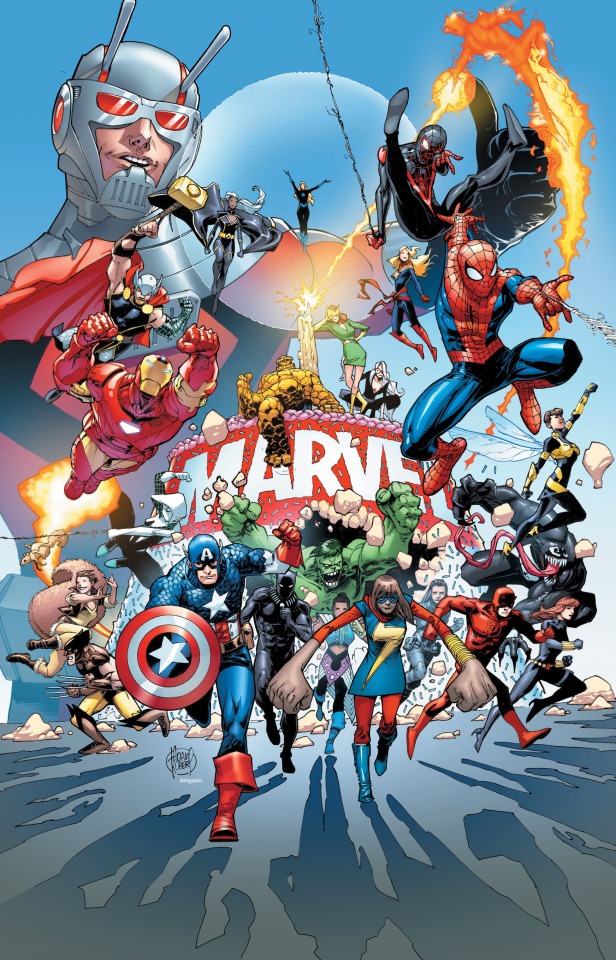
A superhere movie meanwhile is a completely different beast. Ever since “The Avengers” came out in 2012, most superhero movies are 150-250 million dollar behemoths, that get overhyped by advertisement campaigns that are almost equally as expensive and try to trick the audience into believing, that they all are somehow the next big mindblowing thing on the big screen. Plus there hasn’t really been a superhero movie in the last 10+ years, that didn’t release simultaneously worldwide, instead of only coming out in the USA, and then a few months later, in other parts of the world.
So is it any wonder then, if a superhero movie that got advertised like the second coming of a saint, makes 1 billion, when there are already billions of potential customers worldwide all at once when the product launches?
That number btw becomes actually less impressive, once you start to think about how it came to be. Something our blue bear obviously didn’t.
See, on average every movie theater demands like what, 12-14 dollars per movie nowdays?
If we divide the box office of Civil war (1.152 billion btw) with 12 dollars, that makes on average 100 million people worldwide who watched the movie. A bit more than one or two percent of the worlds population. Not to forget, that of the box office success we have to substract such things as production cost of the movie, advertisement, the earnings of the theaters… so suddenly the movie may at best have had only earned one quarter of its box office for Disney as actual profit.
Not to forget, Dobson made that comic in 2018, when superhero movies on average did ring in so much money, because of the hype machine. But now we have 2023 and within the last five years (and especially 2023 itself) we have seen how superhero movies can also utterly fail to make money or even earn just enough to make back the production cost. Birds of Prey, Eternals, Ant Man 3, that Secret Invasion streaming show that still cost over 200 million… Do I need to get on?
Bottom line, Dobson’s indirect jab at comics as the less profitable revenue doesn’t hold that much water really in the real world, where once the hype dies down, comics may actually prove themselves as the more valuable longterm medium. Even if it may just be for the fact, that they end up staying longer relevant in the popcultural subconscious than the current movies, which tend to lose relevance with each new hastily produced and released installment in the franchise.
But where this comic really shines and shows Dobson’s ignorance on a cultural level, is in the last panel. When all off sudden it turns “racial” by claiming that Asian people, unlike “traditional” comic readers (aka white, in Dobbear s eyes therefore instantly racist people), would eat a Marvel character like Amadeus Cho up.
Question Dobson: Why do you assume, they would eat him up? You give no real argument based on anything the character does storywise, that the “target audience” may find admirable. So I can only think, that your reasoning is, because he is ever so slightly east asian coded.

Boy, do we have to unpack not just a can of worms, but a whole package of cans now.
First, the chosen language by saying “eat it up”. When being a writer, you should know that you need at times to choose your words wisely, because of the sheer implications they can carry. And the statement “eat it up” sounds way to close to a negative statement like “suck it up”. Making it come off as if Dobson considers Asian people to be mindless cattle that will consume the grub the House of Mouse will give them without question or any desire for actual quality to it.
Second, it recks of a certain mind set I hate within the American entertainment industry and some of its creators and consumers. That mind set being, that “non-traditional” American cultures supposedly don’t know better than Americans in what is okay for the sake of representation and entertainment or not. It’s a mindset that goes beyond the necessity of e.g. localizing a foreign product to the national market, by e.g. creating a sterilized, corporately mandated and rather unrealistic depiction of another culture within their product, that will fall apart as soon as the people who are supposed to be represented get a proper look at it and realize, how pandering and often times badly researched, if not outright offensive, it is.
Only recently did we see in the world of animation how that can backfire, when Disney released the trailer for “Primos” an upcoming animated show supposedly about a half Latina girl spending her summer vacation with her annoying cousins, people calling it based on the intro (and a leaked pilot) pandering towards a latino audience in a racist manner. And guess what: currently, Disney shelves it and tries to bury its existence like Dobson his old inflation art.
youtube
Dobson himself has actually indulged in that sort of shit kinda, back with his infamous Nintendo comic.
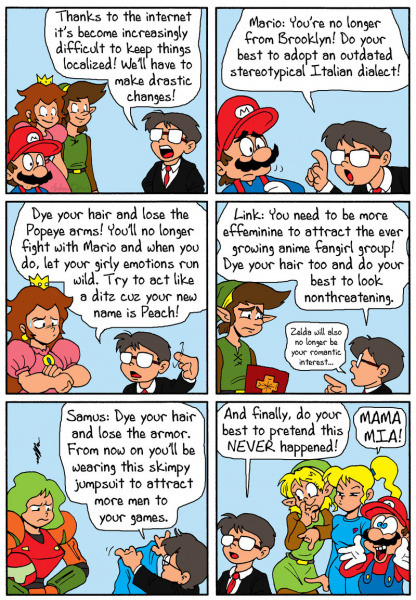
Essentially calling the “true”, Nintendo corporation approved depiction of his childhood Nintendo heroes disgraceful, for not falling in line with the late 80s depictions he saw in localized, made in America products such as the DiC cartoons. That and minor homophobia mixed with misogyny by calling Link “girly” for having longer blond hair since Ocarina of Time and blaming fangirls for it.
Third, and that is kinda related to my prior point, the reality of things is, that “Asians” actually did not eat up that sort of thing in the last couple of years. Sure, there is always that thing about a Chinese market. the big movie companies try to pander to and may succeed with some dumb action flics featuring big robots.
But the reality is, that not even people living in a dictatorship will eat up every trash you give to them, just because it comes from Hollywood or is supported by their glorious leadership. Disney tried to create two pandering messes of movies for Chinese people to watch, called Mulan (the live action adaptation) and that Shang Chi movie. And how did they do there? Oh right! The government did not even allow Shang Chi to be released and Mulan was released but supposedly didn’t do so well, considering (COVID not withstanding) it only made 70 million globally!
Don’t get me even started on every human right controversy in relation to the later, starting with filming in China near a concentration camp and ending with the main actress being essentially a Chinese propaganda puppet.
youtube
So, if those movies flopped, why would Chinese people for example flock for an Asian Hulk? A hulk that is not even Chinese but Korean.
See, this is another issue that fails with the example: The actual choice of character Dobson name dropped is actually kinda terrible.
For those unaware: Amadeus Cho is a supporting character in the Marvel comics, created in 2005 by American writer Greg Pak and artist Takeshi Miyazawa. The later, despite the name being very east Asian, sounding, actually being from Canada. Now both do have east Asian roots so to speak (Pak e.g. is the son of an Korean-american man with a Caucasian woman), but they also have grown up within a society that taught them both western social values more so than we would see in east Asian countries. So with the creators already not necessarily having the most real life experience with the average mindset of a Korean citizen, can we really say that their actual creation helps “represent” those people of a foreign, non-american culture?
And that is not even covering stuff like the actual story of the character itself.
See, in the comics, Cho is supposed to be an American-Korean genius (wish fullfillment much, Greg?) and one of the smartest people in the Marvel Universe. His parents named him after Amadeus Mozart (a pretty white motherfucker as far as I remember) and he grew up under Methodist beliefs. So basically the “Korean heritage” of the character has already been thrown out of the window. Now I don’t expect the character to act stereotypical Korean, listen to K-pop, declare bulgogi to be his favorite dish or any of that shit. But when you want to sell me the character as being in some way or another connected to his ancestral culture, shouldn’t he engage at least in some “Korean coded” things?

I mean, the character of Anne Boonchuy in Amphibia is a Thai-American who acts more like a 13 year old girl that learns to be less selfish and impulsive over the course of the show and whose “heritage” isn’t thrown at us, the viewer, most of the time. In fact, Anne herself acknowledges that she e.g. can’t really speak thai, despite her own mother being fluent in it and a season 3 episode reveals, that Anne is “begrudgingly” a part of the L.A. thai community. And yet, in connection to the shows story and as part of Anne’s characterization, her heritage is acknowledged and plays a part of who she is. Even if it simply means she knows how to cook certain thai dishes, loves her parents and their customs, helps out in their restaurant, can speak a few words thai and knows the basics of Muay Thai, a form of martial arts (and fighting sport) from Thailand.

Amadeus doesn’t even have Korean parents anymore, because they were killed as part of his tragic hero backstory. Nor has he ever visited an Asian country. Oppps.
To build further up on it, Amadeus becomes for the longest time simply a major supporting character in the Marvel universe for the likes of Hulk and Hercules, two white coded characters. Sure, he plays a major role in the defeat of some cosmic horror level villains (such as Mikaboshi in the Chaos God storyline most people forgot even existed) but it takes a long time for him to become a “A-lister” so to speak.
In fact, according to Wikipedia, it wasn’t till after “Secret Wars” in 2016 (eleven years after the character was created), that Amadeus thanks to a chain of events eventually got his chance to Hulk out. And then they still had to kill Bruce Banner to make Amadeus “stand out” initially (don’t worry, Bruce came back. I mean, characters actually staying dead in comics, so that heroes can learn there are consequences? Preposterous) In fact, Amadeus hasn’t really proven himself as a decent “solo” act. Instead he became a member of the Champions (among Miles Morales, Mrs. Marvel, Vision’s daughter Viv. Nova and Cyclops), essentially creating yet another superhero team for teenaged vigilantes. Despite the fact, Cho himself should be by now in his mid 20s.
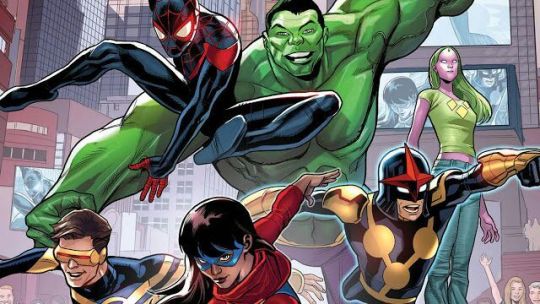
Now look, I do not want to shit talk the character. Partly because I haven’t read everything he was in myself and partly because in the few things I did see him in (both pre- and post Hulk) he was okay. He is a decent hero and person, who tries to do good, even if he screws up here and there. That is something I can admire in a character in general. But he is not a good “representation” of another culture, because his complexion and minor physical features aside, he is NOT embodying even minor values or traditions of that foreign culture. He is simply a Korean-American (or technically Canadian), who falls more on the American side of things.
So essentially, Dobson who virtue signaled on multiple occasions how bad it is when companies he didn’t like tried to speak on behalf of other cultures, would have no problem at all to ask for Asian people to swallow this obviously “Made in American” product. The “Made in America” line actually working both on a metaphorical and a storytelling level, cause trying to google what “east Asian coded” heroes in the Marvel Universe actually come from an Asian country instead of being simply born on American soil, is pretty damn small.
After 20 minutes I only found Shang Chi, as he was born in China, and that character was created as part of kung-fu exploitation in the 70s by white dudes.
Yaiks
However, none of that tops the next two points that really sell Dobson to me as an American centralistic racist. Or at least a twat who doesn’t understand how through bad wording he comes of as ignorant of other people’s cultures.
The way he generalizes Asian people in his statement, while also ignoring the actual accomplishments in the creation of entertainment in multiple Asian countries.
If you’ve read closely what I typed, you may have seen that I used the term Asian at times in tandem with the term “east Asian” to e.g. describe Amadeus Cho.
And that had a very deliberate reason. While I was not a fan of geography in school, even I know that Asia as a continent is not “nationally” as homogenous as let’s say Australia or North America. In fact, Asia is the biggest continent on the planet, hosts more than half of earth’s population and consists of at least 47 internationally acknowledged states.
States such as Turkey, Russia, Afghanistan, Pakistan, India, China, Japan, Malaysia, Thailand, Vietnam, North- and South Korea, Egypt, Israel, Iraq, Iran and so on.
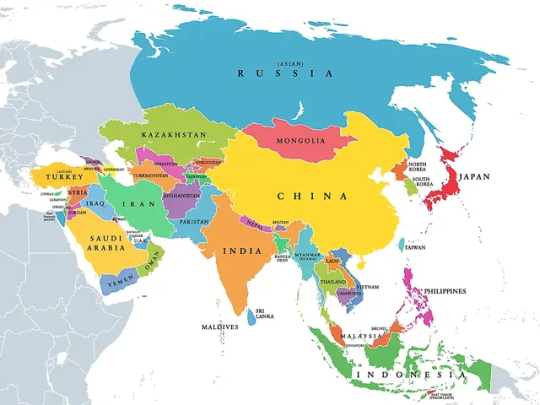
Now what all these states have in common, is that they have their own unique historical, social and “racial” culture and background. Heck, religiously speaking, Asia is the cradle of the world.
As such, Dobson stating that a “Korean coded” character such as Amadeus Cho (who is only Korean on the most surface level and would technically just be a legacy character of yet another white person) would be an immediate hulk smash hit with all these different people of different backgrounds…. Yeah, it sounds like condescending, colonization inspired shit, a smooth brain would come up with.
To Dobson “Asia”, at least based on that comic, is only defined as the “yellow skinned” people from the far east, who like rice, noodles, spicy food and give us anime, Godzilla, fireworks, buddhism and communism. It does not include anyone from the middle east or of more European ancestry. And if you are even remotely familiar about history, you would also know that Japanese, Koreans and Chinese all around do not e.g. like to be thrown into a pot with the others for a variety of reasons. Many of them political.
Or to sum it up even shorter: Dobson insinuated that a very shallow, “east Asian” coded American comic character would be an immediate hit with more than 47 different countries, ignoring that not all of them share the same background despite being part of the “same” landmass. And in doing so, he simultaneously generalized and denounced entire groups of people based on their racial and cultural background, which in as far as I am aware of, is considered racist.
But the “racism” is supposedly justified, because “representation” matters, it would be giving the middle finger to “traditional” comic fans and those nations and their culture are underrepresented globally.
Which is baloney.
Don’t get me wrong, I myself think that representation does matter. But the world does not necessarily rely on the good old US-Ayy only to give it to us.
Cause a lot of the Asian nations I brought up here? They have their own entertainment industry and stories, which again, get ignored by Dobson to make a dumb and false point.
I mean, manga is currently dominating the international comic market, all while Japan has also a booming animation industry and some of the most iconic heroes in modern popculture with the likes of Son Goku, Kamen Rider, Super Sentai etc.
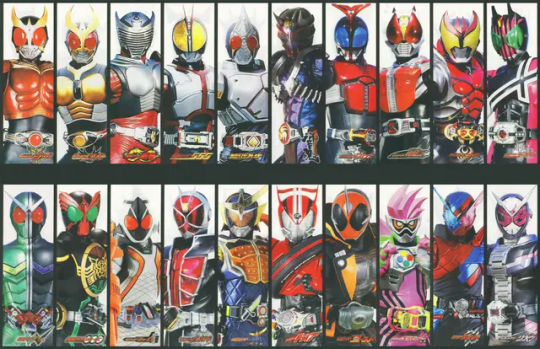
China has a prominent -if propaganda driven- movie industry.
India has Bollywood and delivers some of the most ridiculous but awesome musical movies on the planet.
youtube
Russia had authors such as Tolstoy and movie directors, that redefined the “art” of filmmaking.
Korea had a few years ago one of the biggest streaming hits with Squid Game, while also earning an Oscar for a movie titled Dobs- I mean “Parasite”.
Egypt, Iran, Iraq, Turkey… even nations that have not entertainment living up to “western standards” still produce stuff in some way or form to entertain the masses and their people. Just google up the character Kara Murat aka the avenger of Anatolia.

And don’t get me even started on the sheer ton of mythology, stories and history each of their cultures have provided the world with. Journey to the West? Baba Yaga, the entirety of the Gilgamesh epos...
And yet, there is this indirect assumption by Dobson, that all of them would be so deprived of “heroes” in their media and folklore, they would letch on second hand shop Hulk? Fuck off, Dobbear. I know you like to suck corporate cock as long as you think they are woke and you have childhood nostalgia for them, but this is pathetic. Take Amadeus before A Rama Raju comes around and roundhouse kicks him back to Canada. Then get the taste of mouse smegma of your Disney cock gobbling lips.
#adobsonartwork#syac#hypocrisyofandrewdobson#amadeus cho#racisim#mcu#tom preston#andrew dobson#i am back#back again#guess who's back#Youtube
72 notes
·
View notes
Text
"Nasir Mansoor has spent 40 years fighting for Pakistan’s workers. Whether demanding compensation on behalf of the hundreds of people who died in a devastating 2012 factory fire in Karachi or demonstrating against Pakistani suppliers to global fashion brands violating minimum wage rules, he’s battled many of the country’s widespread labor injustices.
Yet so far, little has improved, said Mansoor, who heads Pakistan’s National Trade Union Federation in Karachi... Regulations and trade protocols look good on paper, but they rarely trickle down to the factory level. “Nobody cares,” Mansoor said. “Not the government who makes commitments, not the brands, and not the suppliers. The workers are suffering.”
Change on the Horizon
But change might finally be on the horizon after Germany’s new Supply Chain Act came into force last year. As Europe’s largest economy and importer of clothing, Germany now requires certain companies to put risk-management systems in place to prevent, minimize, and eliminate human rights violations for workers across their entire global value chains. Signed into law by German Chancellor Olaf Scholz in January 2023, the law covers issues such as forced labor, union-busting, and inadequate wages, for the first time giving legal power to protections that were previously based on voluntary commitments. Companies that violate the rules face fines of up to 8 million euros ($8.7 million)...
...As governments come to realize that a purely voluntary regimen produces limited results, there is now a growing global movement to ensure that companies are legally required to protect the people working at all stages of their supply chains.
The German law is just the latest example of these new due diligence rules—and it’s the one with the highest impact, given the size of the country’s market. A number of other Western countries have also adopted similar legislation in recent years, including France and Norway. A landmark European Union law that would mandate all member states to implement similar regulation is in the final stages of being greenlighted.
Although the United States has legislation to prevent forced labor in its global supply chains, such as the 2021 Uyghur Forced Labor Prevention Act, there are no federal laws that protect workers in other countries from abuses that fall short of forced labor. That said, a proposed New York state bill, the Fashion Act, would legally require most major U.S. and international brands to identify, prevent, and remediate human rights violations in their supply chain if passed, with noncompliance subject to fines. Since major fashion brands could hardly avoid selling their products in New York, the law would effectively put the United States on a similar legal level as Germany and France...
The Results So Far
As of January, Germany’s new law applies to any company with at least 1,000 employees in the country, which covers many of the world’s best-known fast fashion retailers, such as Zara and Primark. Since last January [Jan 2023], German authorities say they have received 71 complaints or notices of violations and conducted 650 of their own assessments, including evaluating companies’ risk management.
In Pakistan, the very existence of the German law was enough to spark action. Last year, Mansoor and other union representatives reached out to fashion brands that sourced some of their clothing in Pakistan to raise concerns about severe labor violations in garment factories. Just four months later, he and his colleagues found themselves in face-to-face meetings with several of those brands—a first in his 40-year career. “This is a big achievement,” he said. “Otherwise, [the brands] never sit with us. Even when the workers died in the factory fire, the brand never sat with us.” ...
-via The Fuller Project, April 2, 2024. Article headers added by me.
Article continues below, with more action-based results, including one factory that "complied, agreeing to respect minimum wages and provide contract letters, training on labor laws, and—for the first time—worker bonuses"
With the help of Mansoor and Zehra Khan, the general secretary of the Home-Based Women Workers Federation, interviews with more than 350 garment workers revealed the severity of long-known issues.
Nearly all workers interviewed were paid less than a living wage, which was 67,200 Pakistan rupees (roughly $243) per month in 2022, according to the Asia Floor Wage Alliance. Nearly 30 percent were even paid below the legal minimum wage of 25,000 Pakistani rupees per month (roughly $90) for unskilled workers. Almost 100 percent had not been given a written employment contract, while more than three-quarters were either not registered with the social security system—a legal requirement—or didn’t know if they were.
When Mansoor, Khan, and some of the organizations raised the violations with seven global fashion brands implicated, they were pleasantly surprised. One German retailer reacted swiftly, asking its supplier where the violations had occurred to sign a 14-point memorandum of understanding to address the issues. (We’re unable to name the companies involved because negotiations are ongoing.) The factory complied, agreeing to respect minimum wages and provide contract letters, training on labor laws, and—for the first time—worker bonuses.
In February [2024], the factory registered an additional 400 workers with the social security system (up from roughly 100) and will continue to enroll more, according to Khan. “That is a huge number for us,” she said.
It’s had a knock-on effect, too. Four of the German brand’s other Pakistani suppliers are also willing to sign the memorandum, Khan noted, which could impact another 2,000 workers or so. “The law is opening up space for [the unions] to negotiate, to be heard, and to be taken seriously,” said Miriam Saage-Maass, the legal director at ECCHR.
Looking Forward with the EU
...Last month [in March 2024], EU member states finally approved a due diligence directive after long delays, during which the original draft was watered down. As it moves to the next stage—a vote in the European Parliament—before taking effect, critics argue that the rules are now too diluted and cover too few companies to be truly effective. Still, the fact that the EU is acting at all has been described as an important moment, and unionists such as Mansoor and Khan wait thousands of miles away with bated breath for the final outcome.
Solidarity from Europe is important, Khan said, and could change the lives of Pakistan’s workers. “The eyes and the ears of the people are looking to [the brands],” Mansoor said. “And they are being made accountable for their mistakes.”"
-via The Fuller Project, April 2, 2024. Article headers added by me.
#pakistan#fashion#fashion industry#fast fashion#labor#labor unions#labor rights#unions#workers rights#capitalism#european union#germany#united states#new york#garment industry#garment manufacturing#supply chain#good news#hope
212 notes
·
View notes
Text
Today Alastair Crooke, speaking on Judge Nap’s show, addresses the cynical Deep State attempt to disrupt Trump’s transition to power. At first glance, of course, the US authorization to Ukraine to use ATACMS for deep strikes into Russia is primarily a morale booster--for the Dems and, supposedly, for the Ukrainians.
But behind this morale raising measure there are other considerations. Within range of these missiles are the Donbas gas reserves, the third largest in all Europe, and there are additional gas reserves offshore from Crimea that can be attacked. The idea that ATACMS targeting will be restricted to "military" sites is probably untrue, since NATO and Ukraine have consistently attacked Russian civilian targets. American companies--Exxon and Haliburton--had put in bids to develop these gas reserves before the war began. The idea was to replace Russian gas to Europe with "Ukrainian" gas from the areas that have now been reintegrated into Russia. The sabotage of the Nordstream pipeline was part of that scheme, since it would be replaced by Donbas and Crimea and Black Sea gas--all under NATO control. In addition, Ukraine--traditionally known as the Breadbasket of Europe--was supposed to supplement European food production. With all the talk of energy we lose sight of the importance of food resources for a populous world--a notion not lost on people like Bill Gates who are buying up US farmland.
The authorization for ATACMS is the last gasp of this project--so reminiscent of NAZI plans from the 1930s and 1940s--to turn Ukraine into a vast NATO protectorate (to use the old colonial era term) to be milked of its resources and to serve as the foundation for the Anglo-Zionist Empire's ultimate suzerainty over Eurasia and the Middle East.
Well, the best laid plans ... It turns out that Russia had different plans, and being subjugated to the Anglo-Zionist Empire was no part of those plans. It also has turned out that the Anglo-Zionists are unable to protect their projected protectorate of Ukraine.
The Central Asian Corridor is where much of the BRICS growth will occur. Energy supply through this area is crucial, and it is why Russia will never sell out Iran. Russia, of course, doesn't need this energy, but the industrial giant of BRICS, China, does. As I have stressed in the past, Iran is the crucial link binding the main BRICS components together.
6 notes
·
View notes